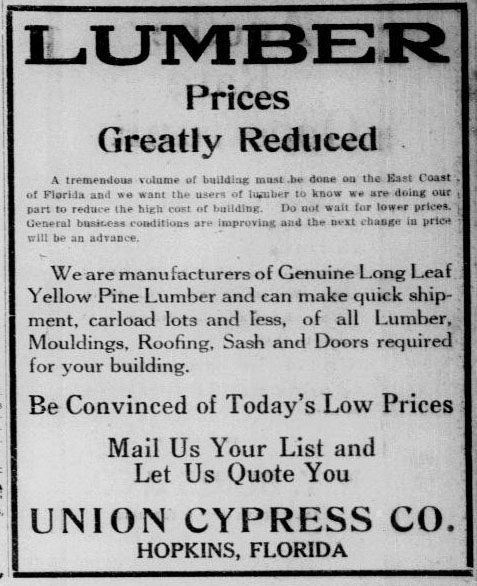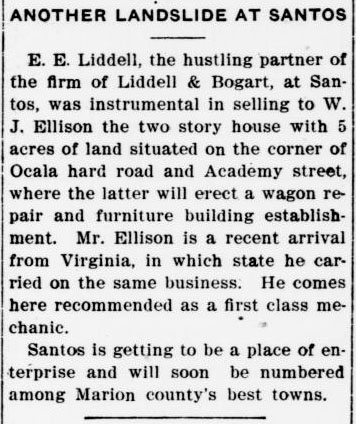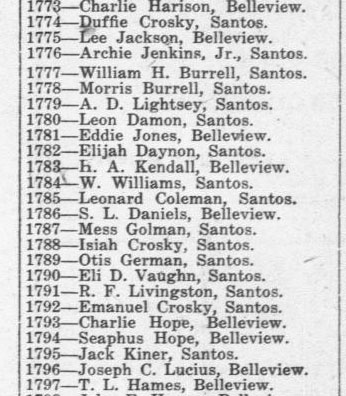
Many horror stories begin with the fateful decision to go explore an abandoned structure or particularly vacant part of the woods, with disastrous results to follow. Because of the role they play in popular imagination, this Halloween blog post is going to shed light on some of the many ghost towns that now dot the landscape in Florida. What is a ghost town? There’s not really one solid answer. Historian John Morris wrote the following in his work Ghost Towns of Oklahoma: “Each writer sets his own limits, depending largely upon the type and location of the places in which he is interested.” Ultimately in his book, he uses the term to refer to “hamlets, villages, towns, and cities (1) that are no longer in existence, all buildings and indications of existence have been either destroyed or covered by water; (2) where the remains of businesses and/or residential structures still stand but are largely unused; and (3) where, in cases of larger places, the population has decreased at least 80 percent from its maximum” (Morris 3). Many of the towns that dotted the Florida landscape in the early 20th century didn’t survive the Florida land boom of the 1920s or the depletion of natural resources (in the case of company towns). Consequently, our papers mention many places that could be classified as ghost towns according to this definition. We hope you enjoy this brief exploration of Florida ghost towns.
Hopkins, Florida was a company town that housed employees of the Union Cypress Company and was named after company founder George W. Hopkins. After a fire in nearby Melbourne in 1919, the company tried to recover, but ultimately shut down in 1925 following the death of its founder. While another company took over in 1928, they were ultimately shuttered by the Great Depression.


Santos, Florida was a primarily African-American community about “six miles south of Ocala on highway U.S. 441” which “received a post office” in 1883 (Nelson 1 and 3). The failed Cross Florida Barge Canal Project, which was authorized by President Franklin D. Roosevelt as a “federal relief program” in 1936, resulted in the destruction of Santos. According to Nelson, descendants of that community “celebrates the memory of the town annually by holding a barbeque and softball tournament” in order to ensure that its memory isn’t forgotten (Nelson 9).



Brewster, Florida is another example of a former company town that is now a ghost town. Established in 1910, Brewster was home to Amalgamated Phosphate, who, as the name suggests, mined phosphate for agricultural use. The company was purchased in 1918 by American Cyanamid, who ran the racially segregated company town until 1962. Photos of now abandoned Brewster can be found on the website Abandoned Florida.



Utopia, Florida, according to genealogists Kyle S. Van Landingham and Alma Hetherington, was founded in 1897 by Clifford Clements “between Lettuce and Cypress Creeks.” Clements was a hunter who operated the store, “but subsequent settlers in the community were fishermen” (Van Landingham and Hetherington Chapter 4). Some reports say Utopia never rebuilt after the 1928 hurricane that devastated the region, while other reports infer community decline started sooner, with the school closing in 1925. Either way, Utopia, Florida has been relegated to history.


Citations and Additional Sources:
Bullet. “Brewster.” Abandoned Florida. September 1, 2011. Accessed October 24, 2017. https://www.abandonedfl.com/brewster/.
Florida Industrial and Phosphate Research Institute. “Timeline of Phosphate Communities.”
Phosphate Primer. Accessed October 24, 2017. http://www.fipr.state.fl.us/about-us/phosphate-primer/timeline-of-phosphate-communities/.
“’Ghost Town’ of Brewster.” Polk-county.com. Accessed October 24, 2017. http://www.polk-county.com/cities/brewster/.
Hendry, Judge William. “Okeechobee County’s Early Communities.” Okeechobee the Magazine. August 2017. http://www.okeechobeethemagazine.com/wp-content/uploads/2017/07/Looking-Back.pdf.
Josh. “Florida’s Own Stonehenge.” The Florida Memory Blog. October 6, 2014. Accessed October 24, 2017. http://www.floridamemory.com/blog/2014/10/06/floridas-own-stonehenge/.
Morris, John W., Ghost Towns of Oklahoma. Norman, OK: University of Oklahoma Press, 1977.
Nelson, Blue. “Structural Racism and the Destruction of Santos, Florida.” African Diaspora Archaeology Newsletter. Vol. 14: Issue 2, Article 4 (2011): 1-12. Accessed October 22, 2017. http://scholarworks.umass.edu/adan/vol14/iss2/4.
Peb. “The Union Cypress Railway.” Marshbunny Notes. Accessed October 25, 2017. http://www.marshbunny.com/stjohns/landmark/uncypress/index.html.
Pike, Jim. “Utopia.” Ghost Towns. Accessed October 15, 2017. http://www.ghosttowns.com/states/fl/utopia.html.
Van Landingham, Kyle S., and Alma Hetherington. History of Okeechobee County. Self- Published, 1978. http://www.lamartin.com/history/history_of_okeechobee_county/history_of_okeechobee.htm.

One Reply to “Ghost Towns of Florida”